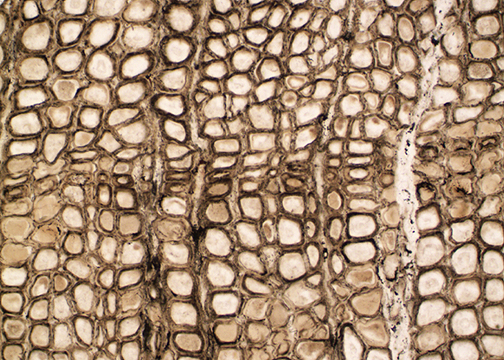Abstract
The Mesozoic gymnosperm genus Shimakuroxylon Philippe, Boura, Oh et Pons is a peculiar petrified wood taxon which was exclusively recorded from the Jurassic–Early Cretaceous interval in eastern Asia. To date, ten occurrences of this genus were documented in Japan, Indochina and Tibet (southwestern China). However, little is known about the record of Shimakuroxylon in eastern China. Here, we describe a new fossil wood specimen from the Lower Cretaceous Laocun Formation in Longyou County of Quzhou City, Zhejiang Province, southeastern China. This fossil specimen exhibits typical Shimakuroxylon anatomy with japonicum-type (shimakurean) radial tracheid pitting and araucarioid cross-field pitting, representing a new record of Shimakuroxylon in eastern Asia. This new finding contributes to our understanding of the fossil wood diversity of the Early Cretaceous xyloflora in southern China, and provides additional data that furthers our knowledge of the palaeobiogeographical distribution of Shimakuroxylon. Shimakuroxylon is commonly suggested as an indicator of warm and wet climates based on its palaeobiogeographical distribution pattern. However, evidence from plant megafossils and sporopollen suggests the local climate of the study area was warm and arid to semiarid during the Early Cretaceous. It is tentatively suggested that the wood plant might have lived in a warm and humid basin margin with relatively sufficient water supply, though the general environmental background might have been arid to semiarid.
References
- Boura, A., Bamford, M. & Philippe, M. (2021) Promoting a standardized description of fossil tracheidoxyls. Review of Palaeobotany and Palynology, 295, 104525. https://doi.org/10.1016/j.revpalbo.2021.104525
- Cao, Z.Y. (1999) Early Cretaceous flora of Zhejiang. Science Press, Beijing, 174 pp.
- Duan, S., Dong, C., Pan, J. & Zhu, G. (2002) Study on the fossil woods found in Xinchang, Zhejiang Province, China. Chinese Bulletin of Botany, 19 (1), 78–86. [In Chinese with English abstract]
- Feng, Z., Wei, H., Wang, C., Chen, Y., Shen, J. & Yang, J. (2015) Wood decay of Xenoxylon yunnanensis Feng sp. nov. from the Middle Jurassic of Yunnan Province, China. Palaeogeography, Palaeoclimatology, Palaeoecology, 433, 60–70. https://doi.org/10.1016/j.palaeo.2015.05.021
- Hass, H. & Rowe, N.P. (1999) Thin section and wafering. In: Jones, T.P. & Rowe, N.P. (Eds), Fossil plants and spores: Modern techniques. Geological Society Publishing House, London, pp. 76–81.
- IAWA Committee. (2004) IAWA list of microscopic features for softwood identification. IAWA Journal, 25, 1–70. https://doi.org/10.1163/22941932-90000349
- Jiang, Z., Wu, H., Tian, N., Wang, Y. & Xie, A. (2020) A new species of conifer wood Brachyoxylon from the Cretaceous of Eastern China and its paleoclimate significance. Historical Biology, 33 (10), 1989–1995. https://doi.org/10.1080/08912963.2020.1755282
- Wang, J., Wang, Z., Liu, Y., Lei, D. & Li, Y. (2019) Burial time constrain and ecological environment analysis of the silicified wood in Quzhou, Zhejiang. Journal of Stratigraphy, 43, 315–323. [In Chinese with English abstract]
- Philippe, M. & Bamford, M.K. (2008) A key to morphogenera used for Mesozoic conifer-like woods. Review of Palaeobotany and Palynology, 148 (2), 184–207. https://doi.org/10.1016/j.revpalbo.2007.09.004
- Philippe, M., Boura, A., Oh, C. & Pons, D. (2014) Shimakuroxylon a new homoxylous Mesozoic wood genus from Asia, with palaeogeographical and palaeoecological implications. Review of Palaeobotany and Palynology, 204, 18–26. https://doi.org/10.1016/j.revpalbo.2014.02.002
- Scotese, C.R. (2014) Atlas of Jurassic paleogeographic maps, PALEOMAP atlas for ArcGIS, volume 3. In: The Jurassic and Triassic, Maps 32–42, Mollweide Projection, PALEOMAP Project, Evanston, IL. http://dx.doi.org/10.13140/2.1.4850.4321
- Shimakura, M. (1936) Studies on fossil woods from Japan and adjacent lands, contribution I. Science reports of the Tohoku Imperial University, 2nd series. Geology, 18, 267–310.
- Sun, G., Cao, Z., Li, H., & Wang, X. (1995) Cretaceous floras. In: Li, X.X., Zhou, Z.Y., Cai, C.Y., Sun, G., Ouyang, S., & Deng, L.H. (Eds), Fossil floras of China through the geological ages (English edition). Guangdong Science and Technology Press, Guangzhou, pp. 310–341.
- Tian, N., Zhu, Z., Wang, Y. & Wang, C. (2018) Occurrence of Brachyoxylon Hollick & Jeffrey from the Lower Cretaceous of Zhejiang Province, southeastern China. Journal of Palaeogeography, 7, 1–8. https://doi.org/10.1186/s42501-018-0008-0
- Xia, G., Tian, N., Philippe, M., Yi, H., Wu, C., Li, G. & Shi, Z. (2020) Oldest Jurassic wood with Gondwanan affinities from the Middle Jurassic of Tibetan Plateau and its paleoclimatological and paleoecological significance. Review of Palaeobotany and Palynology, 281, 104283. https://doi.org/10.1016/j.revpalbo.2020.104283
- Xie, A., Wang, Y., Tian, N., Xie, X., Xi, S. & Uhl, D. (2023a) New occurrence of the Late Jurassic Xenoxylon wood in the Sichuan Basin, southern China: wood anatomy, and paleobiodiversity implications. PalZ, 98, 5–15. https://doi.org/10.1007/s12542-023-00671-9
- Xie, A., Wang, Y., Tian, N. & Uhl, D. (2023b) A new extinct conifer Brachyoxylon from the Middle Jurassic in southern China: Wood anatomy, leaf phenology and paleoclimate. Review of Palaeobotany and Palynology, 317, 104945. https://doi.org/10.1016/j.revpalbo.2023.104945
- Xie, A., Wang, Y., Tian, N., Jiang, Z., Xie, X., Xi, S. & Uhl, D. (2024a) New record of conifer wood Agathoxylon from the Upper Jurassic in the Sichuan Basin, southern China, and its palaeobiodiversity and palaeoclimatic significance. Historical Biology, 1–11. https://doi.org/10.1080/08912963.2024.2322530
- Xie, A., Wang, Y., Tian, N., Xu, M., Jiang, Z., Xie, X., Wang, F. & Uhl, D. (2024b) New record of the conifer wood taxon Brachyoxylon from the Middle Jurassic in southwestern China, and a global survey of paleobiogeography of the Mesozoic Brachyoxylon occurrences. Review of Palaeobotany and Palynology, 322, 105037. https://doi.org/10.1016/j.revpalbo.2023.105037
- Yang, X. & Li, J. (2021) A petrified wood Brachyoxylon from the Lower Cretaceous of Bangoin, Tibet (Xizang), Southwest China. Cretaceous Research, 130, 105064. https://doi.org/10.1016/j.cretres.2021.105064
- Zheng, S., Li, Y., Zhang, W., Li, N., Wang, Y., Yang, X., Yi, T., Yang, J. & Fu, X. (2008) Fossil woods of China. China Forestry Publishing House, Beijing, 356 pp.
- Zhu, Z., Li, F., Xie, A., Tian, N. & Wang, Y. (2018) A new record of Early Cretaceous petrified wood with fungal infection in Xinchang, Zhejiang Province. Acta Geologica Sinica, 92, 1149–1162. [In Chinese with English abstract]


